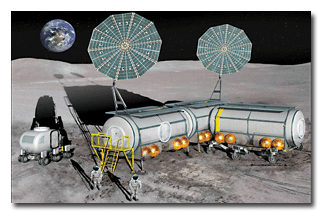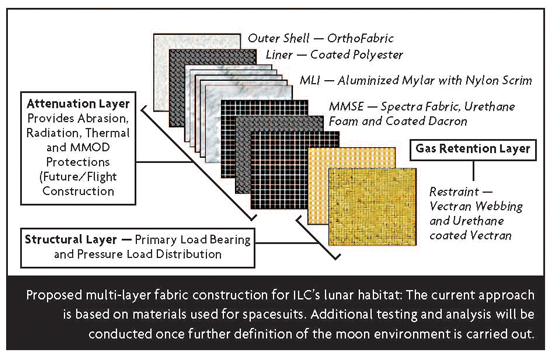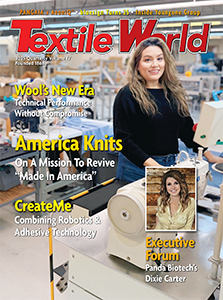T
he street sign at ILC Dover’s headquarters — One Moonwalker Road — gives a strong hint
about what goes on inside the 260,000 square feet of office, development and manufacturing
buildings located there: Spacesuits for the Apollo astronauts in the 1960s and ’70s; gear for the
space shuttle crew that repaired the Hubble telescope in May 2009; and now, inflatable houses
designed for future outposts on the Moon — or even Mars. ILC may need to come up with a new street
name.
A leader in the development of flexible material systems that withstand extreme
environments, Frederica, Del.-based ILC has provided solutions to the National Aeronautics and
Space Administration (NASA) since the early days of the US space program. The company designs both
hardware and softgoods for the wide-ranging challenges of space exploration — from the high heat
of re-entry, to the profound cold of a lunar night, to the airbags that cushioned the landings of
the Mars Rovers. ILC makes a multitude of earthbound commercial products as well, from innovative
containment systems for packaging powder pharmaceuticals to highly advanced protective military
gear.
Still, it’s the inflatable lunar habitat idea that grabs one’s imagination. From the first
Moon landing in 1969 to the last trip there three years later, no one ever spent more than three
days on the surface, and they took the lunar module with them when they left. In the 21st century,
NASA’s Constellation program — to return to the Moon, set up a permanent base, and from there send
people to Mars – started taking shape. This program created a host of new challenges, including the
most basic one: if a crew is living on the Moon for months on end, where is everyone going to
sleep?

ILC Dover is designing habitats for astronauts similar to the cylindrical structures
pictured in this artist’s rendition of an outpost on the Moon, using Abaqus finite element analysis
software from SIMULIA. Image courtesy of NASA.
Launching A House Into Space
ILC’s engineers are working on the answer to that. In partnership with several different
branches of NASA, including Langley Air Force Base and the Johnson Space Center, the company has
been developing ideas for different configurations of lightweight space habitat structures.
“There’s a keen interest among the Constellation management and engineers for softgoods
solutions,” said Cliff Willey, ILC program manager of space inflatables. “When you are launching
equipment into space on a rocket, everything needs to be as lightweight as possible, packed
densely. In the case of a habitat, you want to be able to deploy something that can expand to be
much bigger on the surface of the Moon without a lot of mechanism. An inflatable, soft item is very
good for that.”
ILC recently completed the design work on one such project, a “mid-expandable” habitat with
two hard endcaps and a deployable softgoods section in the center. The endcaps for the current
prototype are being built by NASA Langley Research Center out of low-cost metal, but a lightweight
aerospace composite is envisioned for lunar deployment to reduce mass. For transport, the softgoods
section packs into the endcaps. During deployment, it is unfolded and inflated by air pressure,
more than doubling in length. The midsection’s unique fabric lobe system allows for a structure
that is much lighter in weight but has a higher volume than a similar hard-material configuration
would be. The endcaps are where doors, airlocks and other structures are mounted.

Harsh Lunar
Environment Poses Unique Risks
The Moon’s environment contains a host of external hazards, including extreme temperature
fluctuations — which softgoods withstand much better than metals — plus radiation, dust,
bombardment from micrometeoroids, and low gravity. All these are taken into account by engineers
designing the lunar habitat, which has as many as 10 outer protective attenuation fabric layers
built up over two internal structural layers. Although exact material specifications are still
under study, the outermost attenuation layer will likely be constructed of Ortho-Fabric, which
consists of a blend of Gore-Tex®, Kevlar®, and Nomex® materials. The thermal micrometeoroid portion
of the attenuation layers might be constructed of layers of aluminized Mylar®, laminated with
Dacron® scrim.
But the biggest challenge ILC’s engineers faced when designing the multi-layered habitat was
not external: It was the inflation pressure on the two innermost layers of the structure. “You have
to come up with a pretty clever design to handle the high loads inside a dwelling that is
pressurized to a level in which astronauts can live,” said Ric Timmers, ILC senior analysis
engineer. “The skin load on the internal layers is proportional to the internal pressure times the
radius, so you need to find a material that’s able to handle the pressure on a big structure like
this one, which is 3 meters in diameter.”
In the zero-atmosphere Moon environment, not only do you need to control for oxygen leakage
through the habitat walls, but also, any significant fabric failure would result in a devastating
outward explosion of the structure. ILC’s solution was to design an interlocking webbing net over a
gas-impervious, coated fabric. The 2-inch-wide webbing is constructed of Vectran® in a plain weave
and has an advertised breaking strength of 24,000 pounds. The fabric was deliberately oversized so
that it would bulge slightly between the webbing panels, transferring the pressure load to the
webbing. This unique combination of fabric and webbing working together would allow the habitat to
be inflated to 9 pounds per square inch (psi), an acceptable pressure for humans living on the
Moon, while meeting NASA’s space construction safety standards.
Physical Prototyping
Would Send Costs Out Of Orbit
Testing the integrity of the design on the Moon’s surface was obviously impossible. Building
numerous prototypes out of custom fabric, and pushing habitat models to destruction, would also be
prohibitively expensive, as well as time-consuming.
“Earlier, we were contemplating building a test rig and physically measuring the pressure
load on the fabric, the tension in the webbings, the pressure behind the windows — all
simultaneously — but we were looking at well over $1 million for a test like that,” Willey said.
“That’s when we backed off and decided to go with realistic simulation. We couldn’t be Edisonian
about this, relying on trial and error. We had to be able to build a reliable, finished product
design the first time out.”

ILC’s mid-expandable habitat prototype is stored in two hard endcaps during rocket
transport to the Moon and then deployed on the lunar surface using air pressure, more than doubling
in length.
Realistic Simulation
Provides Down-to-earth Answers
So, the group turned to Abaqus finite element analysis (FEA) software, from the SIMULIA
brand of France-based Dassault Systèmes, to test virtual models of the fabric and webbing under
varying load scenarios. They also used FEA to evaluate the robustness of some minor structural
components, such as the metal brackets holding the webbings. “We relied heavily on analysis with
Abaqus for this project,” Timmers said. “It would have been pretty risky to do this without FEA —
you had to sleep at night!”
Abaqus/CAE, the pre- and postprocessor for the Abaqus Unified FEA product suite, was used to
model the 3-D geometry of the design as the basis for the simulation. The group then ran the
simulation models with two central processing units on a Linux machine using Abaqus/Standard, which
provides all the material, geometry, and loading nonlinearity needed to simulate fabric structures.
“Our models were fairly straightforward, so static loading was appropriate for what we needed to
know,” Timmers said.
FEA Helps Identify
Safe Fabric Yield Strength Limits
ILC began its analysis of the fabric/webbing system by modeling a unit cell of fabric
constrained by a square of the webbing net. “We used a simple planar approach for this analysis
since the out-of-plane curvature of each unit cell was negligible relative to the full radius of
the entire habitat,” Timmers said. When setting up the model, the group measured the sides of the
cell from webbing center to webbing center instead of from webbing edges. “We used the midpoints
rather than the edges because we wanted to be more conservative in our analysis by imagining that
the webbing wasn’t there, as a sort of worst-case scenario,” Timmers said.
To model the fabric itself, membrane elements were selected, and all degrees of freedom at
the perimeter of the unit cell were held fixed. Then, the model was oversized slightly, using what
Timmers calls “a neat thermal expansion coefficient technique” that raised the temperature until
the fabric expanded to a set percentage, to simulate the bulge of fabric between webbings. Finally,
the nominal 9 psi of pressure was applied to the model, and Abaqus calculated the resulting stress
in the material. With a center load result of 74 pounds per inch (lbs/in), and an edge load of 84,
the material was well within NASA’s required safety factor of four, as the ultimate tensile
strength of the fabric was approximately 500 lbs/in.
“Using Abaqus FEA to identify the allowable limits of the fabric’s performance was very
useful because with this type of structure you have to be really sensitive to total mass,” Timmers
said. “When we found one material that worked, we could use Abaqus to virtually test another,
lighter material to see how much we could save on total weight and still provide the right factor
of safety.” The final fabric selected for the lunar habitat was a 0.0075-inch-thick, 200-denier
Vectran with a urethane coating impermeable to gas leakage. The weave is plain, with a yarn count
of 50 by 50 threads per inch. The ultimate tensile strength is 551 lbs/in in the warp direction,
and 520 lbs/in in the fill direction.
Keeping The Web Of Safety Intact
In addition to low stress in the fabric restraint system, another important contributor to
the habitat’s stability was evenly balanced loading of the ring of webbing itself. To test this
part of the design, the ILC team used Abaqus to simulate just the critical axial, or end-to-end,
length of the webbing. Hoop webbings around the circumference are more isolated from one another
and are less sensitive to any uneven lengths among them. The purpose of the model was to simulate
“manufacturing uncertainties” that might unexpectedly shorten the length of a single webbing.
“Our biggest concern this time was that any deviation in the length of one webbing could
foreshorten the whole system, concentrating 100 percent of the load on a single section and leading
to a cascade of breakage,” Timmers said. The team set up their model with all 26 axial webbings
fixed to a flat plate representing the hard endcap of the habitat. The usual 9-psi pressure load
was applied to the surface of the plate to simulate conditions in an inflated habitat. When one
webbing was shortened by just 0.125 percent, the analysis results showed that the load on it jumped
to 4,815 pounds, versus 3,600 pounds on the rest of the webbings. But since the breaking strength
of the Vectran webbing chosen for the habitat was 24,000 pounds, the safety factor of four was
still met.
How long will such a well-designed structure last on the Moon? “The intended design life of
the lunar habitat is at least 10 years,” Timmers said. While accelerated aging studies on the
component materials and creep testing on webbing material have already been carried out, additional
long-term durability studies are still pending.
Camping On The Moon, Mars
— Or Even Just The Antarctic
With their habitat design complete, ILC teamed with NASA to build a prototype for “Camping
on the Moon,” now on display at NASA Langley. Real-world verification tests of a full model —
including a deployment run-through, a high-pressure test, and tear-resistance evaluation — are
pending further funding.
“We may very well run these tests ahead of time with Abaqus,” Timmers said. “It’s ideal to
use a combination of modeling and testing back and forth, applying FEA to dial into just a few
possible scenarios.”
Whatever the timeline for deploying astronaut habitats on the Moon or Mars, ILC’s unique
approach to such structures has applications closer to home as well: potentially as hyperbaric
chambers for health clubs or hospitals; or, already, as dwellings for polar- or desert-based
scientists. A similar habitat designed with Abaqus Unified FEA has been tested in the harsh
environment of the Antarctic and will be going to the Arctic as well. The polar habitat model had
requirements around wind, snow and ice loading, all of which are absent on the Moon, so the
material selected was several layers of polyurethane-coated nylon separated by layers of
Thinsulate™.
What will the address be in the Arctic — One Icewalker Road? The ILC engineers hope One
Marswalker Road is not that much farther away.
Editor’s Note: Lynn Manning is a science and technology writer based in Providence, R.I.




